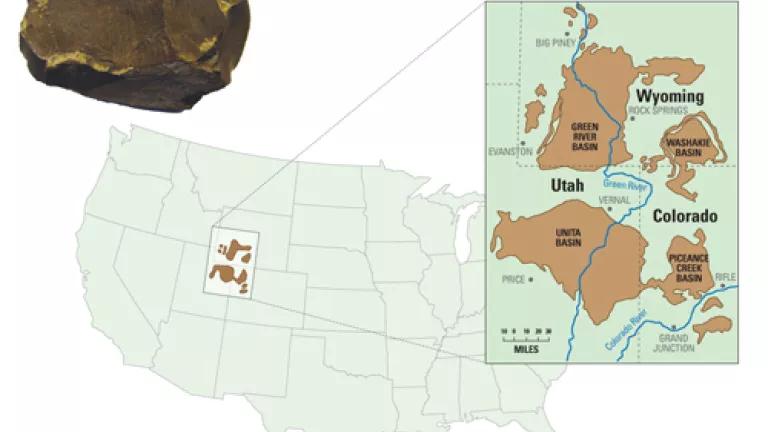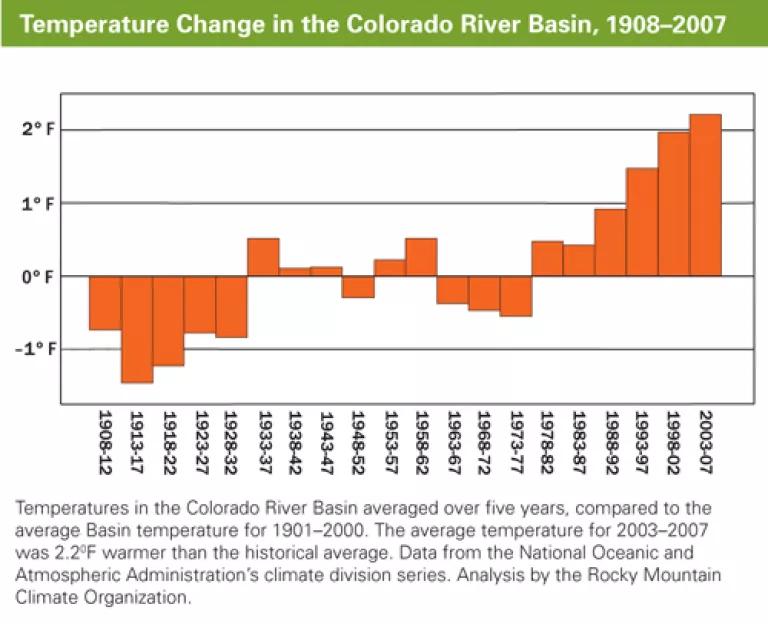
At a time when management of the Colorado River Basin water supply is facing unprecedented challenges due to over allocation and climate change, energy companies are proposing to move forward with oil shale development - a water intensive, inefficient source of energy that could become a major producer of greenhouse gas pollution. NRDC’s new report Between a Rock and a Dry Place explores the potential impacts of oil shale development on water supplies in the Basin and on the region’s agricultural economy, water quality, protected species and natural environment.
Oil shale is an immature rock source that, when heated and processed (using an average of almost 5 barrels of water per one barrel of oil), becomes a kind of liquid petroleum. Although there are many small deposits of oil shale in Wyoming, the states of Colorado and Utah contain more than 60 percent of the world’s known oil shale deposits.
For decades, energy companies have sought to exploit these deposits as a new source of energy but significant constraints, including the high water and energy requirements as well as impacts to the environment, have prevented development on a large scale. However, as the price of oil rises, so does interest in oil shale development.
Mid-range estimates by the Government Accountability Office and a report by Western Resources Advocates find that oil shale development in Colorado could consume about 360,000 acre-feet of water – one and half times as much as the city of Denver.
A potentially significant new source of greenhouse gas pollution, oil shale development is more bad news for Basin water users. With warming already occurring, the West is ground zero for climate change. In fact, as the graphic below shows, the Colorado River Basin is warming faster than the rest of the country. And in the West hotter means drier. Recent studies have shown that Colorado River Basin runoff could be reduced by as much as 25% by 2050 if greenhouse gas emissions are not reduced.

This new report focuses primarily on potential water supply related impacts from the large amount of water that oil shale production would consume. If this energy source moves forward in the Colorado River Basin, it could impact 30 million people from Wyoming to Southern California, including farmers who grow 15 percent of the nation’s crops, who depend on the Colorado River as a major source of water supply.
Key findings of this report include:
- The Colorado River Basin is over subscribed. When the Colorado Compact was signed in 1922, the average yield from the Basin was estimated to be 17.5 million acre-feet (maf). Recent Studies by the Bureau of Reclamation have indicated that the long-term average natural flow at Lee Ferry may be closer to 14.7 maf. For the past decade, water use in the Basin has exceeded available supply. The average annual use in the Basin has averaged 15.3 maf since 2000.
- Agriculture in Colorado would be hit hard. Energy companies have already obtained senior water rights which they have not yet exercised; if they do so and if subsequent analysis concludes that there is limited or no undeveloped water in the Upper Basin, most of that water is expected to come from agricultural water users.
- Scenic natural lands, fish, and wildlife would be impacted by oil shale development. Oil shale deposits occur in areas of Colorado, Utah, and Wyoming that are known for their natural beauty. Large-scale oil shale development would not only mar the landscape with industrial infrastructure, but also impact threatened species in the region. Increased water supply demands could impact tributary rivers like the Green River and make it more difficult to restore four listed species efforts on the Colorado River.
- Climate change will reduce Colorado River Basin water supplies. Many studies have concluded that the Colorado River Basin is ground zero for the water management impacts of climate change. An already arid climate will become even warmer, reducing snow pack, increasing evaporation, and causing other changes. The U.S. Climate Change Science Program has predicted runoff decreases of 10 to 25 percent by 2050—roughly 5 to 12 times Denver’s water use. The Bureau of Reclamation has concluded that flows will decrease by 9 percent over the coming 50 years.
- Oil shale production and refining results in significantly higher greenhouse gas emissions than conventional oil fuels. Well-to-wheel greenhouse gas emission estimates for oil shale show it to have 23 percent to 73 percent (1.2 to 1.7 times) greater emissions in comparison to diesel.
The Colorado Basin States are at a crossroads. The water management practices and uses of the past cannot continue. This report makes key recommendations to chart a course toward a more sustainable water management future that maximizes efficient use of Colorado River Basin supplies. (My colleague Ed Osann has more to say about water efficiency here.) The report includes the following recommendations:
- Do Not Pursue Oil Shale Development. Based on current information about the wide range of environmental impacts and existing technologies, oil shale development should not be pursued. The costs are too high, and the benefits of increased energy are too small and easily made unnecessary with energy-efficiency measures. Further studies of oil shale must do more than merely overcome the technological challenges that have stopped the development of a full-scale industry. The significant environmental impacts of such development must be prevented. Such an industry must be investigated in the context of a climate that is already warming and will be made worse by oil shale development.
- Develop new comprehensive state water management strategies. The Basin states individually and as a whole, in collaboration with the Bureau of Reclamation, should undertake analyses of the range of actions that are available to reduce water consumption basin- and state-wide by 10 to 25 percent from current levels. This analysis should investigate options for limiting new consumptive uses (such as oil shale) and the potential for urban, agricultural, and industrial conservation.
- Protect sensitive or protected lands from oil shale leasing. The oil shale regions in the upper Colorado River Basin are home to some of the most spectacular landscapes in the nation, as well as to wildlife that is currently listed under the Endangered Species Act. Oil shale development should not include lands occupied by or designated as critical habitat for threatened or endangered species, designated Areas of Critical Environmental Concern, or lands where oil shale development would permanently impair the productivity of the land or the quality of the environment.
- Implement regional greenhouse gas reduction efforts. The Basin states should work together to reduce the future risk of climate change by implementing state-level legislation, and use existing legal authorities to reduce greenhouse gas emissions. Basin states should explore the potential for creating an enforceable state-level cap on carbon pollution, similar to California’s AB 32.
- Prioritize energy efficiency. Basin states can reduce greenhouse gas emissions by modernizing building codes to reduce energy consumption related to buildings.
- Promote cleanest forms of energy. Promote low or nongreenhouse gas-emitting and water-efficient sources of energy such as wind, solar, and geothermal sources that provide water supply, climate change, and energy-efficiency benefits.
If oil shale development moves forward, it will compete with farms and cities in the West for limited water supplies that will become scarcer because of climate change. The time is now for the Bureau of Reclamation and Colorado River Basin states to tackle this challenge head on, through effective planning, water smart energy policies and dramatic investments in water use efficiency – the reliable water supply of the future.
